Last Dance, Last Chance Read online
Page 34
Elledge was turned over to the New Mexico Parole Board for a hearing in Santa Fe. He still had ten years hanging over him for an earlier sentence for assault and robbery. He hadn’t proved to be the ideal candidate for parole.
Detectives DePalmo and John Boren flew to New Mexico to bring Elledge back to Seattle to face charges of first-degree murder. Jim Elledge said he was afraid to fly, and under New Mexico law he had the right to refuse to fly, so DePalmo and Boren had to take the tediously long train trip with their prisoner handcuffed to them. Once arraigned in Seattle, he was held without bail.
James Elledge went on trial in Judge Horton Smith’s courtroom in March 1975. His defense was “diminished responsibility” because of his long history of alcoholism.
The jurors didn’t believe it, particularly when they heard how he had bought the hammer hours before Bertha Lush was killed. They returned with a verdict of premeditated first-degree murder with the use of a deadly weapon.
Under existing Washington statute, Elledge’s earliest release would be in 13 years, four months plus a mandatory five years for the deadly weapon. This was to run consecutively to the 10-year New Mexico sentence. The jurors who convicted Jim Elledge believed that he would not be released until he was almost 60.
For Elledge, prison was safer than being on the outside. He rapidly became institutionalized. He admitted that he “didn’t feel comfortable at all” outside prison, and almost all of his crimes had been exacerbated by imbibing alcohol. In prison, he had limits, and he knew he would have a bed and three meals a day.
Although it didn’t excuse his crimes, anyone who knew James Elledge’s background might understand that—as well as wonder that he survived to grow up. He had begun life in a rural area in Louisiana, living in grinding poverty.
Elledge was one of six children in a family that could barely afford to raise one child. He was closer to a sister than he was to his parents, who had no time for him. But she died when he was 6. In his family, the answer to despair was alcohol. “I started so durned young in drinking,” he once said. “Hell, I’m talking about a little kid—7, 8 years old. I think that’s what destroyed me.”
Elledge’s father was committed to a mental institution when Jim was 10, and a few months later Jim was arrested for breaking and entering. His long rap sheet began.
After his father went insane, his mother began to drink, too. She couldn’t cope with supporting five children emotionally or financially.
Jim’s father died when he was 13, and two of his half-siblings committed suicide, allegedly because they were grief-stricken over the loss of their father. His mother would always blame Jim’s trouble with the law on the loss of his father.
Jim went to reform school in his early teens. He was badly burned while working in the kitchen there, and spent months in the hospital. Even so, he preferred reform school to his home. He once asked his parole officer to put him back in prison because he was literally “starving” at home. He was told that they couldn’t do that; his sentence was up.
He left home when he was 15, seeking some life that might be better than what he had known. He was 21 when he was arrested for his first serious crime: he kidnapped a Western Union Clerk during an armed robbery in New Mexico in 1964.
In 1966, while Elledge was serving time for that robbery, he managed to slither through an air vent and escape from the New Mexico Penitentiary. Recaptured, he made yet another attempt at freedom: He jumped from a second-story window at the city jail, but he was free for only 11 hours.
His records showed that he had tested as “very intelligent,” but psychological tests indicated that he suffered from antisocial personality disorder, meaning, essentially, that he had no conscience.
When Kim Lane met Jim Elledge on the bus, she saw a rather attractive man—a man who told lies with a great deal of conviction. But she sensed the danger there.
Jim wasn’t a complete sociopath. He was a survivor, but he seemed to have episodes of feeling empathy for others. Had his childhood not been so cruel, he might have grown up to be an entirely different man.
Three years after he went to the Washington State Penitentiary, he tipped prison officials to an escape plot planned by several high-profile offenders. They were well on their way to tunneling out of the prison. “Snitches” don’t last long in prison, and his life was threatened.
He was moved to a prison in Atlanta for protection. Ten years later, during the Cuban prison riots in the Georgia prison, he risked his life again—this time to save a prison guard. The Cubans were about to take a prison lieutenant hostage and gain control of his ring of security keys—keys that would open a series of doors that led to the outside. Jim barred a door between the rioters and the guard and said he “would fight for as long as he could hold out.”
He earned his GED high school equivalency diploma in prison, and he went to classes in anger management and support groups for substance abusers. His sentence was reduced from premeditated first-degree murder to second-degree murder.
Still, every time Jim was paroled, he managed to do something that violated the trust placed in him, usually after he had been drinking. He was released on parole after 14 years, but in 1989 he got drunk and tried to rob a tavern in Louisiana. And back he went to prison. It may well have been that he actually craved the security of being inside, away from the world. He never seemed upset about going back.
On one occasion when he broke the rules of his parole, a corrections officer wrote in 1990: “No use. Might as well go get him and attempt to save another life.”
Jim was now back in Washington State. “It is obvious that Mr. Elledge cannot adjust to life outside of prison,” a community corrections supervisor wrote in 1994, warning a parole review board. “Be extremely careful in deciding if you ever want to let him out of prison. I believe he is at high risk to kill again.” The supervisor said he had little hope for Jim Elledge’s “redemption.”
But Jim was placed in a work-release program that year, the first step in allowing him to go entirely free. He soon got drunk and walked away from work-release. He went back to prison.
Elledge became a Christian in prison after a delegate from the Free Methodist Church came into the penitentiary to minister to him. And he was finally paroled from the Monroe Reformatory in 1995. He moved to Tacoma, Washington.
Jim Elledge was no longer the muscular tanned man with the crew cut who had murdered Bertha Lush. He had aged in double-time while he was locked up. He was thin and balding, and his short gray beard and moustache and horn-rimmed glasses made him resemble an Amish elder more than an ex-con.
He looked harmless. But he knew there was another side to him, a violent side that he had to struggle to control. Rage often bloomed in him.
Duane Grooters, who had come into the Monroe Reformatory to share the Bible with him, believed that Jim could learn to be good. The Free Methodist Church had a portion of their belief system that said they must help prisoners, using compassion, to seek the right path. “Jim seemed like someone who really had a desire to change. He had a desire to get out and do something and help others and make it on his own.”
Although the Lynnwood Lighthouse Free Methodist Church that had helped him while he was in prison was fifty miles north of his apartment in Tacoma, Jim took a bus to attend services there. He eventually moved to Lynnwood after one of the church members, Bill Hubbard, who was a local city councilman, said he could sleep on his couch.
“Jim was like a cheerleader to me,” the good Samaritan said. “He greeted me with coffee after late nights at work or council meetings. This guy would cook and clean. He was a real trouper.”
Jim walked three miles to the red brick church for Bible study, and never missed Sunday service. The Lighthouse Free Methodist Church hired him as a janitor. He was popular with the members, a very friendly and likable man. Many knew he had been in prison; fewer knew what his crimes had been.
Jim found a girlfriend who loved him and agreed to marry him.
She described herself as “slow,” but Jim made her feel smart and beautiful. He and his fiancée, Ann, were married in late 1997. He started a little side janitorial business. He seemed to have made it through, despite the warnings of corrections and parole officers.
Sometimes he drove by the cemetery where his 1974 victim was buried. “Bertha,” he recalled. “Bertha Maude. Every time I’d drive by the graveyard out there where’s she’s buried at—well…I just felt so damn guilty.”
Jim Elledge might as well have had “love” and “hate” tattooed on either hand; the compassionate, helpful side of him did exist, but so did the vengeful, angry part of him. He harbored intense hatred for a woman named Eloise Fitzner, who was 47 and single. She lived in the Sherwood Springs Apartments in Lynnwood in a unit upstairs from the apartment Jim shared with Bill Hubbard, his benefactor. Jim got to know her there in the mid-nineties. But it wasn’t Eloise he was attracted to—it was her friend, Rita Bentson*, 39, who fascinated him.
“He loved her,” Lynnwood Detective Mike McBride said later. “He had the hots for her. It was not a mutual feeling at all.”
Rita, fifteen years younger than Jim Elledge, wasn’t the least bit attracted to him. Besides that, he was newly married to Ann; he was practically on his honeymoon.
Eloise just didn’t like him. That was unusual because Eloise Fitzner liked almost everyone. Eloise was an attractive woman who wore her dark blond hair in bangs. Her photographs usually showed her smiling, even though she had suffered for years with fibromyalgia that left her with severe muscle pain much of the time.
“Eloise was always on the side of the lost and the wayward, always pulling for the underdog,” her brother, Mike Helland, commented. “She often bonded with people who needed help.”
Nothing had worked out in Eloise’s life, but she still had an optimistic attitude. Born in Spokane into a happy family, she had gone to secretarial school and worked in Hawaii, Houston, and New Orleans. Neither of her two marriages succeeded, and one was marred by domestic violence. Frightened by her husband’s threats and stalking, she moved far away to escape him. Eventually, she came back to Washington State.
Eloise Fitzner was dedicated to God, Bible study, and her church—which was a different church than the Free Methodist church, where Jim worked. She was a compulsive rescuer of animals and people who needed her, even though her chronic disease often confined her to bed.
Maybe Eloise didn’t like Jim Elledge because she was sensitized to men who could be cruel to women. Perhaps she had encounters with him that frightened her. At any rate, she warned both Rita Bentson and Jim’s wife, Ann, to put him out of their lives. Without thinking of the consequences, Eloise had written letters to Ann, trying to get her to think twice about marrying Jim, warning her about “that horrible man.” She continued to warn Ann even after she and Jim were wed.
Ann didn’t listen. From the time she met him where he worked as a part-time janitor at a Boeing assembly plant, she had liked Jim, and she didn’t believe Eloise Fitzner was right. She thought Eloise was lying when she said Jim was cheating on her—or trying to cheat on her with Rita.
But Ann told Jim that Eloise was badmouthing him, and he was furious. “There’s something wrong with my nature,” he explained later. “I had been able to control a lot of it by the power of prayer [but] the hate and the anger that was inside me just came up, and I made up my mind that I was going to get my evens with this woman.”
It was April 18, 1998. It was spring again in the Northwest, almost exactly 24 years from the time that Bertha Maude Lush had died violently a few miles south of Lynnwood, Washington.
Jim Elledge had decided to kill Eloise Fitzner.
She was a naive, gullible woman who didn’t realize the demons she had unleashed in Elledge with her constant meddling. Her friend Rita recalled that Eloise was actually excited when he knocked on her apartment door that Saturday in April. She was willing to forgive him. Jim had on pressed black slacks and his good shoes. He explained that his wife, Ann, was away at a church retreat.
“He told us he had presents for us at his church,” Rita said. “He said, ‘I have a lot of nice gifts for you girls, and you’re really going to like these gifts.’ He told Eloise that she should bring her car because we’d need it to get all our gifts home. He even said he would treat us to dinner out afterward.”
Eloise had asked, “Oh! Can we go to the Olive Garden?”
“Sure,” Jim said easily, “I’ll take you to the Olive Garden.”
Neither woman got many chances to go out to dinner in a restaurant, and they couldn’t afford to go themselves. Now, they suddenly had plans for a Saturday night out. They got dressed up. Eloise put on a red linen skirt and a pale blue satin blouse. The two women even took photographs of each other so they could remember how good they looked all dressed up.
They left Eloise’s apartment in her light blue 14-year-old Buick Skylark. They were going to meet Jim at his church. What could be safer than meeting a man they thought they knew at a church?
Neither Eloise nor Rita knew that Jim Elledge had once murdered a woman, or even that he had spent almost 20 years in prison.
It was nearly 8:30 in the evening when Jim Elledge, Eloise Fitzner, and Rita Bentson walked into the church. Jim seemed surprised to see that one of the assistant pastors was there, writing his sermon for the next morning. The pastor was a little surprised, too. He smelled the women’s perfume before he saw them, and he noticed that Jim hadn’t turned on the foyer lights as he’d led the women inside.
Jim introduced his friends to the pastor and said he was going to give them a tour of the church. The minister nodded and went back to his sermon. When he was finished, he left the church, aware, but unconcerned, that Jim and his friends were probably still inside.
Sometime on Sunday, Lynnwood police got an almost hysterical call from Rita Bentson. She had a terrible story to tell them.
Rita told detectives about Jim Elledge’s invitation the night before. But there had been no gifts and no dinner out. Instead, she said he had taken them to an inner room of the empty church and barricaded the door.
Suddenly, he’d had a knife in his hand and some lengths of rope that he must have already cut to the size he wanted. Rita said Jim had tied them up, binding them at their wrists and ankles with the rope.
“Then he covered my eyes with a sweatshirt,” she sobbed, “so I couldn’t see what he was doing.”
But she could hear. She knew that he was strangling Eloise, and it sounded as if he was stabbing her, too. She heard Eloise beg, “No! Stop…I can’t breathe!” After that, there was only silence.
Rita waited, still helpless in her bonds, while Elledge went someplace with Eloise. And then, she said, Jim had taken her to the mobile home in Everett where he lived with Ann. But Ann wasn’t there, and Jim had sexually assaulted Rita several times before he finally released her.
Rita didn’t have any idea where he was at the moment, but she was afraid he might come back for her.
Lynnwood Detectives Jim Nelson and Steve Bredeson were assigned to the case. That Sunday night, they went to the Lighthouse Free Methodist Church, looking for Eloise. Humans alone couldn’t have found her, but they had a search dog with them. The dog led them to a crawl space in the lower part of the church.
Eloise was there, her hands clasped together as if she were praying. But she was dead. She was still tied with carefully measured lengths of nylon rope. The discoloration in her face, the broken blood vessels, and the ligature marks around her neck showed that she had been strangled. She has also been stabbed in the throat in a sadistic overkill.
The Lynnwood detectives soon learned that Jim Elledge had a long criminal record that included murder. They put out a Wanted computer memo on him, sending it to the 13 Western states, and then all over America. Elledge had always been a traveler—at least, when he wasn’t locked up.
He was probably driving Eloise Fitzner’s car, which was missing. Rita told detectiv
es that he had told them to bring the car because they would need it to carry home all the presents he was going to give them.
The blue Buick was found at 2:30 in the morning on Tuesday on South Commerce Street in Tacoma, sixty miles from Elledge’s Everett trailer.
Jim Elledge might have been tired of running, or he might have finally faced the reality of the other side of his nature, the dark side. At 9:30 on Tuesday morning, he called Tacoma police and told them that he wanted to surrender. He told the dispatcher that he was staying at the Morgan Motel in the south end of Tacoma. He was as good as his word. As police pulled into the motel parking lot, Elledge walked out with his hands in the air. He had been staying there, he said, since Sunday.
Lynnwood detective Steve Bredeson felt that Elledge had come to the end of his resources. His image was all over newspapers and television, and he was running out of money. He didn’t dare drive his victim’s car, and he wouldn’t get far on foot. Maybe he was only sick of fighting the violent impulses that whispered in his ear.
The man that Lynnwood detectives transferred back to their jurisdiction didn’t look like a murderous monster. He looked like what he was: a wimpy, aging church janitor. He told them that he’d tried to kill himself—twice—but found he didn’t have the nerve.
He admitted to police that he had killed Eloise, but he denied raping Rita Bentsen. “I hope I get the justice that Eloise got,” he said bleakly. “And that’s death. I want it so bad you can’t believe it.”
The congregation that had held out a hand of friendship and encouragement to a long-term prisoner was stunned, more so because Jim Elledge had chosen their sacred building for the scene of brutal murder. “Things like that aren’t supposed to happen in a church,” a departing member said. “Did I experience anger? Yes, I did.”

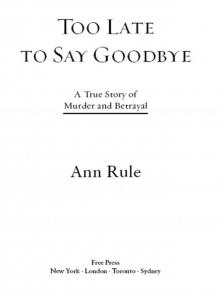 Too Late to Say Goodbye: A True Story of Murder and Betrayal
Too Late to Say Goodbye: A True Story of Murder and Betrayal Green River, Running Red
Green River, Running Red Bitter Harvest
Bitter Harvest Dead by Sunset: Perfect Husband, Perfect Killer?
Dead by Sunset: Perfect Husband, Perfect Killer?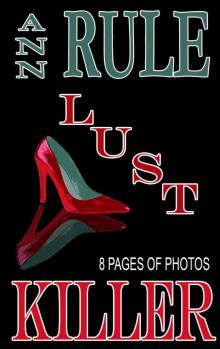 Lust Killer
Lust Killer And Never Let Her Go: Thomas Capano: The Deadly Seducer
And Never Let Her Go: Thomas Capano: The Deadly Seducer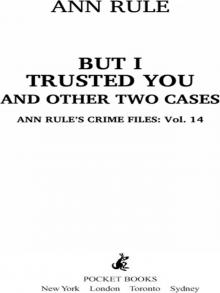 But I Trusted You and Other True Cases
But I Trusted You and Other True Cases Smoke, Mirrors, and Murder and Other True Cases
Smoke, Mirrors, and Murder and Other True Cases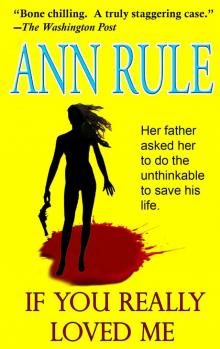 If You Really Loved Me
If You Really Loved Me Kiss Me, Kill Me and Other True Cases
Kiss Me, Kill Me and Other True Cases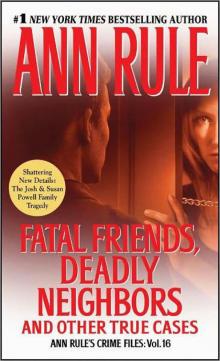 Fatal Friends, Deadly Neighbors and Other True Cases
Fatal Friends, Deadly Neighbors and Other True Cases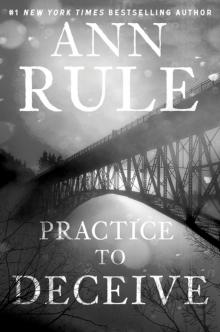 Practice to Deceive
Practice to Deceive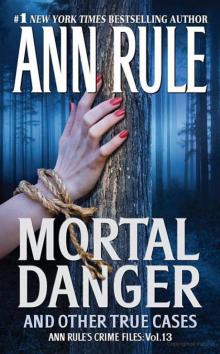 Mortal Danger and Other True Cases
Mortal Danger and Other True Cases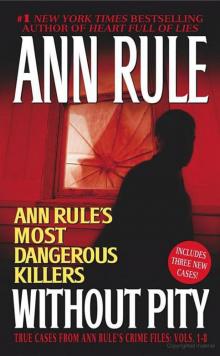 Without Pity: Ann Rule's Most Dangerous Killers
Without Pity: Ann Rule's Most Dangerous Killers Everything She Ever Wanted
Everything She Ever Wanted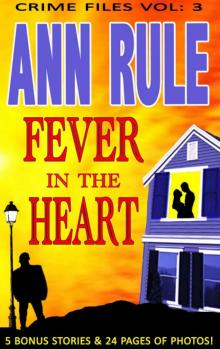 A Fever in the Heart and Other True Cases
A Fever in the Heart and Other True Cases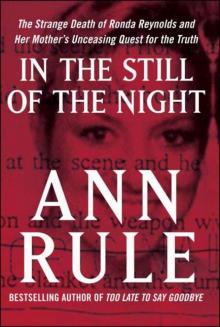 In the Still of the Night
In the Still of the Night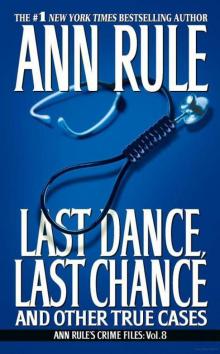 LAST DANCE, LAST CHANCE - and Other True Cases
LAST DANCE, LAST CHANCE - and Other True Cases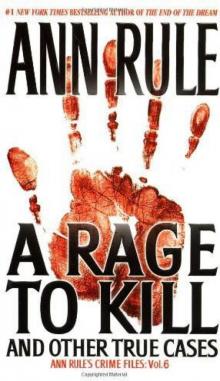 A Rage to Kill
A Rage to Kill The I-5 Killer
The I-5 Killer The Stranger Beside Me
The Stranger Beside Me Everything She Ever Wanted: A True Story of Obsessive Love, Murder, and Betrayal
Everything She Ever Wanted: A True Story of Obsessive Love, Murder, and Betrayal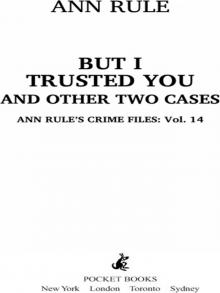 But I Trusted You
But I Trusted You Without Pity
Without Pity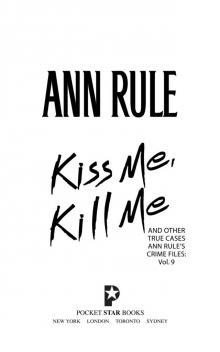 Kiss Me, Kill Me
Kiss Me, Kill Me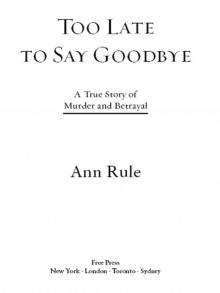 Too Late to Say Goodbye
Too Late to Say Goodbye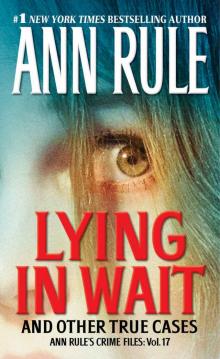 Lying in Wait
Lying in Wait Fatal Friends, Deadly Neighbors
Fatal Friends, Deadly Neighbors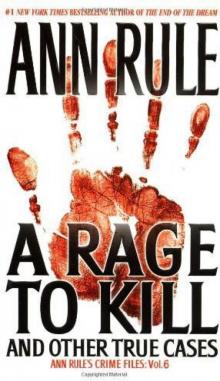 A Rage to Kill: And Other True Cases
A Rage to Kill: And Other True Cases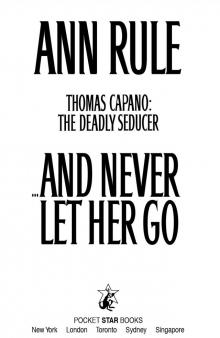 And Never Let Her Go
And Never Let Her Go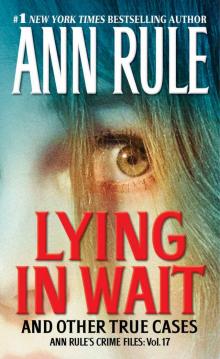 Lying in Wait Ann Rule's Crime Files Vol.17
Lying in Wait Ann Rule's Crime Files Vol.17 Blood Secrets: Chronicles of a Crime Scene Reconstructionist
Blood Secrets: Chronicles of a Crime Scene Reconstructionist No Regrets
No Regrets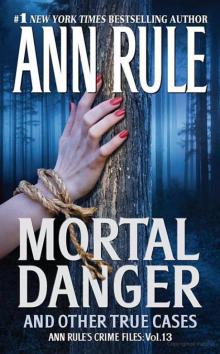 Mortal Danger
Mortal Danger But I Trusted You: Ann Rule's Crime Files #14
But I Trusted You: Ann Rule's Crime Files #14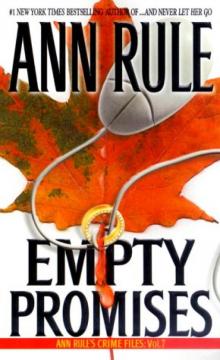 Empty Promises
Empty Promises Dead by Sunset
Dead by Sunset Last Dance, Last Chance
Last Dance, Last Chance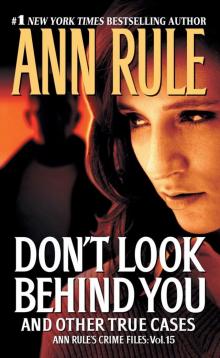 Don't Look Behind You
Don't Look Behind You